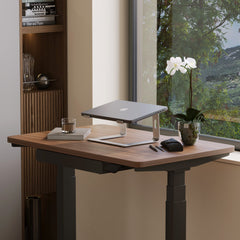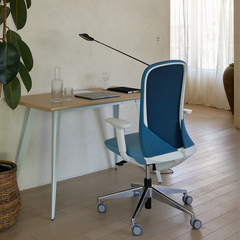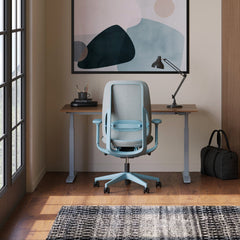Get 10% off your first order
Find the office furniture that’s designed to match your style, comfort, and needs perfectly. Subscribe
The Shape of Focus: How Furniture Design Influences Remote Work Habits

Visit quiz page to see how we makes it easy to create an inspiring workplace

Hardwood and tile are resilient, but the finishes that protect them respond differently to rolling, sliding, and concentrated weight. On hardwood, grit trapped in a wheel can behave like fine sandpaper and create micro-scratches. On tile, rigid wheels can chatter across grout joints, concentrating force at the edges where tiles are most vulnerable. The right chair choice reduces friction peaks, spreads load over a larger contact area, and keeps finishes intact during everyday movement.
A chair’s base and wheel geometry determine how force travels to the floor. Wide diameter wheels, five-point bases, and materials that slightly deform under load lower point pressure so the finish does not experience sharp impacts. Chairs that track straight and swivel smoothly also avoid the tiny stop-start motions that etch dull rings around desks.
Wheel hardness determines how the wheel interacts with microtexture in the surface. Softer wheels conform slightly, which lets debris embed into the wheel rather than the finish. On tile, a slightly compliant wheel bridges grout joints so the ride remains smooth and quiet. On hardwood, that compliance reduces the likelihood of a wheel digging through the topcoat.

Wheel material is the first line of defense between the chair and the floor. Polyurethane and rubberized blends are friendlier to hard finishes than rigid nylon. Bearings matter as well. Quality bearings roll with less stutter, which prevents scuff marks that come from wheels skipping under load.
| Caster Type | Typical Hardness | Best Use on Hardwood | Best Use on Tile | Noise Level | Notes |
|---|---|---|---|---|---|
| Polyurethane single-wheel | Medium-soft | Excellent with smooth tracking | Very good across grout | Low | Gentle on finishes, easy to source |
| Polyurethane dual-wheel | Medium-soft | Excellent with higher stability | Excellent for heavier users | Low | Distributes weight, resists flat spotting |
| Rubberized tread over nylon core | Soft surface layer | Very good with strong grip | Excellent when floors are glossy | Very low | Quietest option, ideal for open spaces |
| Hard nylon | Rigid | Poor without mats | Fair on matte tile | Medium-high | Use only with protective mats |
| Felt-capped glides | Soft, non-rolling | Excellent for stationary seating | Good on smooth tile | Very low | Best for dining or lounge chairs |
Many office chairs ship with hard nylon wheels by default. Swapping to soft casters is often simple and provides an immediate improvement in surface safety and noise. If the chair will live on glossy tile, a rubberized tread can improve traction to prevent sudden slips when standing up.
For dining rooms, studios, and media rooms where rolling is not a priority, glides with felt or silicone pads create a stable footprint that protects finishes and slows vibration. The key is to choose glides that fully cover the contact point and to replace pads once they compress or collect grit.
An ergonomic chair should encourage micro-movements without forcing the user to push hard to reposition. Smooth tilt mechanisms, balanced recline, and low-friction swivels keep movement fluid so wheels roll rather than scrape. A chair with a stable base and soft casters reduces the likelihood that users drag the chair into position.
If you prefer a premium task build that rolls cleanly on delicate finishes, consider the Novo chair with soft-roll casters. Controlled movement lowers abrasion on hardwood, and the soft wheel blend crosses tile transitions with minimal vibration.
Chair finishes affect acoustics and the way the piece feels on contact with the floor. Matte or brushed bases hide minor dust better than mirror-polished metal, which can encourage owners to clean wheels more frequently to avoid noticeable smudges. Upholstery texture also matters. Heavier textiles dampen sound and can make a rolling chair feel quieter in a room with a lively echo.
For living spaces where the chair is part of the visual story, a design-forward frame can still be gentle on hard floors. A sculpted profile with broad feet or soft wheels spreads load without calling attention to the hardware. For a modern silhouette that remains floor-conscious, explore the Muse sculptural armchair.
A light-toned floor highlights scratches, so wheel quality and cleanliness are essential. Choose soft casters, a five-point base, and a fabric or mesh back that keeps the footprint visually light. Keep a small handheld vacuum near the desk to clear grit before it migrates into wheels.
Tile is tough, yet grout lines can telegraph through the wheels of a heavily loaded chair. Select dual-wheel soft casters and consider a flat-woven mat only where cutting or sanding happens. The goal is to catch debris at the source rather than masking it with a thick mat that can curl at the edges.
If movement is minimal, a stationary seat with broad glides preserves the floor’s finish and keeps sound low. A gentle, enveloping shape works well. The Seashell molded lounge seat is an example of a supportive shell that distributes weight evenly while still feeling airy in open plans.
Task chairs used for long sessions should maintain a neutral path when rolling back and forth. Misaligned caster forks can cause wheels to scrub at an angle. Look for chairs that track straight without wobble when you nudge them from the side.
If you want a chair engineered for long working hours that still respects hard surfaces, the Onyx performance task chair provides balanced lumbar support and fluid motion. Pair it with a clean floor routine to keep rolling resistance low and finishes pristine.
Desk height and depth influence how far the chair travels during a typical day. A deeper work surface increases the rolling envelope, so caster quality becomes more important. Use a desk with clean cable routing to avoid snag risks that cause abrupt wheel locks.
A stable desk discourages overcompensation through the chair and reduces jerky movements that can scuff floors. See modern desks from Urbanica for anchored designs that complement seating built for hard floors.
On tile and sealed wood, hard reflections amplify wheel noise. Softer wheels, well-sealed bearings, and padding on contact points are the most effective ways to reduce rattles. Upholstered seats and area rugs that do not interfere with rolling can also dampen the room.
If tile has pronounced bevels or wide grout, pick wheels with a slightly larger diameter and a soft tread. Larger wheels reduce the frequency of impacts so the sound is less noticeable and the ride remains smooth.
Wood floors expand and contract with humidity. During dry seasons, small gaps can appear at board seams. Use soft wheels that will not catch on minor ridge lines and keep humidity within manufacturer recommendations so the floor remains flat and the chair base stays true.
Tile is dimensionally stable, but grout can become more brittle if it dries excessively. Avoid narrow, hard wheels that focus weight along grout edges. Regularly inspect grout near high-use stations for fine cracking and seal as needed.

Transitions between rooms can create a small step that wheels must climb. A compliant wheel tread and steady approach angle keep contact smooth. If the threshold is tall, a low-profile mat on the higher side can reduce the step height while protecting the finish where the chair turns.
If a single chair must cross from hardwood to tile daily, prioritize a caster that performs well on the more delicate surface. Usually that means choosing the softest wheel that still provides stable tracking on tile.
A simple schedule does more for surface protection than any single accessory. Once a week, pop hair and dust from casters with a brush or compressed air. Wipe wheel treads with a damp microfiber cloth and dry them before rolling. Inspect glides for embedded grit and replace felt pads that have packed down.
Use cleaners that are compatible with your floor’s topcoat and avoid strong solvents on wheel treads. Harsh chemicals can harden or crack soft wheels, which increases friction and noise.
On softer or recently refinished hardwood, a high-quality mat can provide peace of mind. Choose mats that lie completely flat with beveled edges. Avoid mats that yellow or become brittle. For tile, select a mat with a textured underside so it does not skate across glossy finishes.
Pads should match both chair leg shape and floor finish. Round felt pads work for square legs only if the pad diameter fully covers the corner radius. If pads keep slipping, clean both surfaces with alcohol and choose adhesive designed for sealed wood or polished tile.
1. Identify the dominant surface where the chair will live.
2. Determine the primary movement pattern. Long rolling arcs require better wheels than a mostly stationary setup.
3. Choose a base with five points for task seating or broad glides for lounge seating.
4. Select soft or rubberized casters sized to bridge grout or minor seams.
5. Confirm that the swivel and tilt mechanisms operate smoothly with minimal effort.
6. Align the chair’s finish and texture with the room’s visual language.
7. Set a maintenance cadence for wheels, glides, and floor cleaning.
Cables that drape across the floor are a hidden source of scuffs. Route them through grommets or along the desk leg so the chair never snags and jerks. If you use an area rug, place it outside the rolling lane so wheels do not climb onto edges that can flip and scrape the finish.
A chair cannot protect the floor on its own if the workstation encourages awkward movement. Combine stable seating with a solid writing surface to keep motions smooth. For compatible furniture that supports consistent ergonomics, review modern desks from Urbanica.
Chairs that enable small posture changes reduce strain. Smooth casters and predictable swivel resistance make those adjustments natural so users do not drag the chair to reposition. For credible occupational guidance on designing around human movement, consult NIOSH ergonomics guidance.
Recycled aluminum bases, low-VOC finishes, and replaceable wheel modules extend product life without compromising performance. Replaceable casters also let you adapt the chair when you change rooms or renovate flooring.
Glides, felts, and wheels are wear items. Keeping a small kit of replacements on hand ensures the chair always meets the floor in a clean, soft state. When a wheel starts to chip or a felt compacts, swap it before damage begins.
A home with hardwood in the office and tile in the dining area benefits from tailored components rather than a one-size approach. Use soft casters in the office and felt glides in the dining room. To experiment with coordinated combinations, explore the Build Your Bundle configurator.
If you want to view options by form factor, finish, and base style through a single lens, browse the Urbanica chair collection. Filtering by room type and material makes it easier to match chairs to the exact surface underfoot.
Seat height should let your feet rest flat while your hips and knees sit near ninety degrees. That position lowers the urge to push hard against the floor to reposition. Wheel radius matters too. Larger wheels roll over minor seams instead of skittering along them.
Measure the turning circle from the center of your desk to nearby walls or cabinets. A chair that fits the space will not constantly pivot in tight radii, which reduces scuffs at fixed points on the floor.
Chair feels gritty when rolling: clean treads and vacuum the rolling lane.
Wheels leave dark marks on tile: inspect treads for embedded rubber from shoe soles and switch to a rubberized or polyurethane tread if needed.
Chair drifts on glossy surfaces: use rubberized wheels or add a low-profile mat with a textured underside.
Pads keep slipping: clean surfaces with alcohol, allow to dry, and use pads sized to the leg footprint.
If a wheel shows flat spots, chips, or a cracked hub, replace the set. Mixed casters can cause the chair to lean, which increases localized pressure on the floor.
Match cool gray tile with brushed aluminum or satin nickel chair bases. Pair warm hardwoods with matte black for contrast or tone-on-tone bronze for a quieter look. Upholstery that picks up a secondary hue from the floor pattern creates harmony without camouflage.
Open layouts benefit from soft-close mechanisms and smooth casters. The quieter the hardware, the more calmly the room feels, especially in spaces with tall ceilings or glass.
Roll forward and back five times across the same path. Listen for chatter or squeaks.
Swivel 360 degrees and check for a smooth return with no grabbing.
Inspect wheel treads for embedded grit after the test and clean if needed.
Confirm that the base does not rock when weight shifts between hips.
Verify that glides or pads remain centered after minor repositioning.
Measure the rolling lane for snags, cables, or rug edges.
Design movements influence how chairs integrate with flooring across different regions. In North America, open-concept homes with hardwood emphasize sleek ergonomic profiles that roll quietly across large living areas. In parts of Europe, where ceramic or natural stone tile is more common, chairs tend to feature glide feet and subtle curvature that echo traditional craftsmanship while protecting grouted seams. Coastal and humid climates often favor corrosion-resistant aluminum bases that perform reliably when ambient moisture levels fluctuate. Recognizing these distinctions helps designers and homeowners choose seating that aligns with both aesthetic traditions and environmental demands.
The architecture of a room dictates how furniture interacts with the floor. Scandinavian-style interiors with pale wood finishes benefit from lightweight, minimalist chairs that maintain visual openness. In contrast, Mediterranean spaces with patterned tile floors favor seating with simple silhouettes and neutral tones that don’t compete with decorative flooring. Regional building materials also affect acoustics; dense stone floors amplify sound differently from engineered oak or bamboo. Selecting soft, quiet-moving chairs improves acoustic comfort in these echo-prone environments and supports a cohesive design narrative.
Different regions emphasize distinct maintenance routines. In humid or coastal zones, sealing hardwood more frequently reduces swelling and protects against salt-induced corrosion on chair bases. In urban environments where dust accumulation is higher, wheel cleaning and pad replacement should occur more often to avoid surface haze. These local habits inform the ideal chair specification, ensuring each selection meets the demands of its setting while maintaining comfort and longevity.
Responsible furniture manufacturing increasingly reflects local resource availability. Regionally sourced woods and recycled aluminum reduce transportation impact while maintaining structural integrity. Soft casters and felt components can also be produced from renewable or recycled materials specific to local supply chains, linking environmental responsibility directly to regional design ecosystems. This localized approach strengthens both sustainability and economic circularity within communities that value long-term craftsmanship.

The Shape of Focus: How Furniture Design Influences Remote Work Habits

Work That Flows: Designing a Home Office That Actually Works

Gaming vs Executive Chairs for Remote Workers
Get 10% off your first order
Find the office furniture that’s designed to match your style, comfort, and needs perfectly. Subscribe
Leave a comment